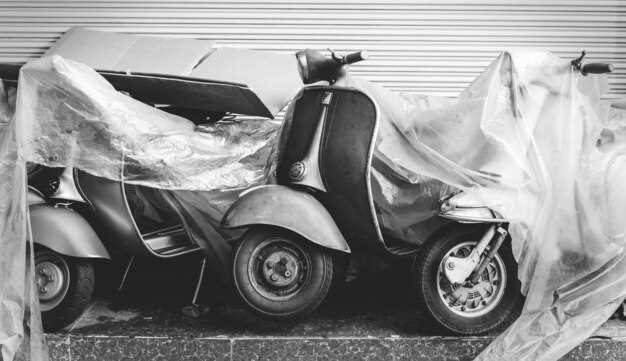

As winter approaches and riding season comes to an end, it’s essential to properly prepare your motorcycle for storage. Taking the time to winterize your bike can help prevent damage from harsh weather conditions and ensure your motorcycle remains in optimal condition for the next riding season. This process involves several key steps that protect various components, maintain performance, and prolong the life of your vehicle.
Before you tuck your motorcycle away for the winter, consider draining fluids and changing the oil. Old oil can contain contaminants that may harm your engine if left stagnant. Additionally, it’s critical to fill the tank with fresh fuel and add a fuel stabilizer to prevent gunk formation. This will keep the fuel system clean and ready for action when spring arrives.
Another vital aspect of winterizing your motorcycle is to clean and protect the exterior. A thorough wash followed by a wax application can shield the paint and metal from corrosion. Pay attention to the tires as well; check for proper inflation and consider elevating the bike to prevent flat spots from forming during prolonged disuse. Taking these precautionary measures will go a long way in ensuring that your motorcycle comes out of hibernation ready to hit the road.
Preparing the Fuel System for Long-Term Storage

To ensure your motorcycle’s fuel system remains in optimal condition during storage, it’s essential to take specific steps to prevent fuel degradation and corrosion. Start by draining the fuel tank to remove any old fuel. Leaving old fuel in the tank can lead to varnishing and clogging of the fuel lines and injectors.
Next, consider adding a fuel stabilizer to a fresh tank of gasoline. This product helps to prevent the fuel from breaking down and forming harmful deposits. After adding the stabilizer, fill your tank completely to minimize air space, which can lead to condensation and rust formation.
Run the engine for a few minutes to ensure that the stabilized fuel circulates through the entire fuel system, including the carburetors or fuel injectors. Afterward, shut off the engine and ensure that the fuel system is sealed tightly, preventing any potential leaks or evaporation.
Additionally, if your motorcycle has a carbureted engine, it may be wise to drain the float bowls. This step helps to eliminate any residual fuel which could evaporate and leave behind deposits or lead to corrosion.
Finally, remember to inspect the fuel lines and connections for any signs of wear or damage before storing your motorcycle. Replacing cracked or brittle hoses will minimize the risk of leaks and ensure the longevity of your fuel system when you take your bike out of storage in the spring.
Protecting the Battery and Electrical Components
To ensure your motorcycle’s battery and electrical components remain in optimal condition during storage, start by removing the battery from the bike. This helps prevent it from discharging due to parasitic draws while sitting idle. Clean the battery terminals using a wire brush and a mixture of baking soda and water to eliminate corrosion.
Next, fully charge the battery before storing it. A fully charged battery is less susceptible to freezing temperatures. Consider investing in a smart battery maintainer or trickle charger. This device will keep the battery charged and can extend its lifespan significantly. Make sure to connect it properly and check the manufacturer’s instructions.
Store the battery in a cool, dry place, away from direct sunlight and moisture. Extreme cold can negatively affect battery performance, so avoid leaving it in unheated garages or sheds. If your motorcycle has an anti-theft system or other electronic components, ensure they’re turned off to avoid draining the battery.
As for the electrical components, inspect all wiring and connections for wear and damage. Look for frayed wires or exposed connections, as these can lead to short circuits or other issues. Apply dielectric grease to connectors to protect them from moisture and corrosion during storage.
Lastly, if your motorcycle has a fuse box, check the fuses to ensure they are in good condition. Replacing any blown fuses before storage can prevent electrical issues when you prepare to ride again. By following these steps, you can safeguard your motorcycle’s battery and electrical components, ensuring a smooth start when the riding season resumes.
Maintaining the Tires and Exterior Finish

Before storing your motorcycle for the winter, it’s essential to ensure that the tires and exterior finish are in optimal condition. Proper maintenance during this period not only protects your bike but also enhances its longevity.
Tire Maintenance: Start by inspecting the tires for any signs of wear, such as cracks, bulges, or uneven tread wear. If you find significant damage or low tread depth, consider replacing the tires before storage. Ensure that the tires are adequately inflated to the manufacturer’s recommended pressure. Low air pressure can lead to flat spots developing over the winter months. If possible, elevate the motorcycle or use tire stands. This reduces the weight on the tires and minimizes the risk of flat spots.
Another precaution is to clean the tires using a mild soap solution. Remove any dirt, debris, or brake dust that could contribute to deterioration over time. Additionally, consider applying a tire protectant to shield the rubber from drying out and cracking during storage.
Exterior Finish Maintenance: To preserve your motorcycle’s exterior finish, start by washing it thoroughly. Use motorcycle-specific cleaners to eliminate grime and road salt that can lead to corrosion. After washing, dry the bike completely to prevent water spots and rust formation in hard-to-reach areas.
Once clean, apply a high-quality wax to provide an additional layer of protection. Waxing not only enhances the shine but also acts as a barrier against moisture and contaminants. Pay special attention to areas where the finish might be exposed to elements and road debris.
Inspect and clean critical components like mirrors, lights, and chrome parts. Consider using a chrome cleaner for added shine if applicable. Finally, store the motorcycle in a dry, temperature-controlled environment to further protect both the tires and the exterior finish throughout the winter months.






